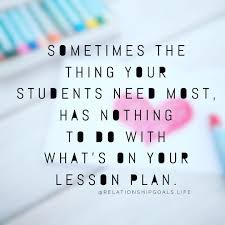
There’s much debate right now about what essential means and who that means. In education, everything feels essential! Good teachers augment, dig deep, toss glitter. We don’t retract ourselves, our content, or the potential of our students.
It just feels weird.
I need to think about what happens after the fact, when the surprise is over and there’s a sliver of space to think, to plan for a physical separation from our students the next time.
There. I said it.
So what? Now what?
Once I work with students face-to-face again, here are five essentials we might prepare:
Relationships.

Build a relationship that you will miss when we’re behind screens. We usually rely on the first few classes to make connections with students, notice them deeply, their friends, their connections to school, peers, their parents. We use the information we gather by simply being near.
- Ask students to create a meme, video, short blog post, cartoon, something that helps you know who they are in a digital space. A student who is chatty in person may struggle to write bullet points, record a short video, or respond in an online discussion. This will impact how they show you they know content (think assessment!) in a digital space.
- If you distribute surveys to students about their interests at the beginning of the year, add questions about access to the internet, the devices in their home, and the digital platforms where they feel comfortable. If you need this information, you will already have it.
- Intentionally build connections in a digital space and the face-to-face space from the first day to demonstrate the legitimacy of relationship and rapport no matter what. Our students communicate and build relationships in a digital space with or without a pandemic. Lean into it with a class Instagram, class Twitter, or other appropriate social media spaces. Establish this in person and you will be able to draw on the investment when interactions are remote.
Remote Spaces.
Get to know your students’ learning preferences. All of our learners have a jagged learning profile, and most teachers plan pre-assessments and benchmarking during the first weeks of school. But the game changes in an online space. One of my teacher friends joked that teaching remote is like sipping a bit too much bubbly–it augments our personalities, leverages our strengths, and highlights where we struggle.
We are different teachers online.
Our students are different learners online.
When instruction moves online, we can’t rely on our in-place tricks of the trade. Students may have a media self that operates differently than the one we think we met! We need to know that learner. How do we interact in a face to face culture? How do we interact in an online culture? What is your teaching identity in the cloud?
Interruptions.
Know your content in a standards-based environment. Interruptions to learning means we need to know what our students KNOW, not what they have DONE. If you haven’t yet organized instruction based on standards or standards groupings, now is the time!
If I have written success criteria (what it looks like to meet the standards) and proficiency scales (what learning looks like while moving toward the standards), I can identify what a student has learned when class is disrupted. A proficiency scale outlines learning on the way to a target, which gives me (or another instructor) crucial knowledge about student learning.
One way to collect this data in any teaching environment is to overhaul your grade book. Replace “assignment” with “standard” or “learning target.” Clearly name the target–I like to write the whole thing out–in this way you will know what has been accomplished within your class, but you will also be able to clearly communicate competencies and gaps to a future instructor.
Sharing the Gap.
Instructors tend to collaborate with teachers of the same content or the same grade level. While this helps create common learning outcomes and assessments, it doesn’t give us information about learning that was intended prior to our course or the expectations of what comes after.

I can better serve students if I’m willing to openly share data in a vertical space. This means that I share the learning outcomes of my course with the instructors that feed my course, but it also means I am transparent about my students’ proficiencies with the instructor or programs that come after. For example, I teach an undergraduate course for secondary education majors the semester prior to their internship. In the internship, students are required to write and enact lesson plans. The majority of their field practice was interrupted this semester and we didn’t learn how they respond to teaching a whole class. It is my responsibility to share that information with their mentor teachers and university liaisons so that we can intentionally address the gaps and ensure success.
Substitute and Slash.
I can make do with less.
John Hattie’s research identifies strategies that best lead to student learning. Everything we do impacts student learning, but his meta-analysis identifies what works best. Once we identify the essential teaching strategies, this might provide a focus for ALL of our teaching. We might find strategies we tried because we “had to” are more effective than a past strategy. It’s possible that some of what we have been doing doesn’t impact student knowing.
One year, I had a student teacher who was in a horrible accident. The damage impacted his speech and he developed a stutter that became worse when he was nervous. He was worried that students wouldn’t be able to understand when he was giving directions, so he created an avatar and typed in what he wanted the avatar to say for him. The avatar spoke clearly, but it could also be played over and over again for students who needed a scaffold. He uploaded it to the class website for parents.
Creating a remote identity improved student learning.
Learning a new strategy improved his practice.
I don’t want to talk about what’s next.
I think: This isn’t what I signed up for.
But I did, because I’m a teacher.


